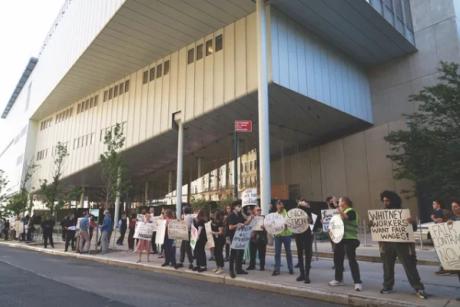
Has there been a moment in recent US history when labour movements were more prominent than they are right now? In September, Joe Biden became the first sitting president to appear on a picket line when he joined striking auto workers in Michigan. That same week, the Writers Guild of America emerged from its 148-day strike against Hollywood’s biggest studios with a historic deal. The Screen Actors Guild-American Federation of Television and Radio Artists finally ended its strike on 8 November after 118 days.The auto and film industries have been heavily unionised for almost a century. But organised labour is relatively new to most museums in the US. Over the past four years, workers have formed unions at more than 20 art institutions, from the Baltimore Museum of Art to the Frye Art Museum in Seattle. To date, workers at 17 museums have successfully ratified contracts with management. On 8 November, the Brooklyn Museum union became the latest to do so.So far, much of the press attention has focused on the path to a deal: the elections, the social-media campaigns, the protests, the strikes. But what happens after a contract is in place? How does day-to-day life change for workers? And how are legacy institutions adapting to new ways of operating?I liken it to being a solo detective and, all of a sudden, you’ve been assigned a partner and you have to get used to working together Jordan Barnes, union steward“I liken it to being a solo detective and, all of a sudden, you’ve been assigned a partner and you have to get used to working together,” says Jordan Barnes, a library assistant at the Museum of Fine Arts Boston, and the chief steward of its union.While many museums employ unionised workers as facilities and security staff, they are not accustomed to working with wall-to-wall unions, which cover a broader swathe of employees. Both sides are figuring each other out. “A lot of the terms are still new, and sometimes there can be a bit of fogginess as to what they mean,” says Joseph Eichstaedt, the chair of the union committee at the Milwaukee Art Museum (MAM) and a member of the museum’s visitor services department.Some unions have clashed with management over how to implement the new contracts. “It takes just as much organisational work to put the contract into effect as any other stage of the process,” says Adam Rizzo, a museum educator and the outgoing president of the Philadelphia Museum of Art (PMA) union. Union members and PMA management are currently at loggerheads over “longevity pay”, or rises awarded to staff based on seniority. The question of who qualifies, and how much money they should receive, is now moving into arbitration. Rizzo admits the language in the contract is “kind of ambiguous”, but believes the union’s terms were clear during negotiations. A PMA spokesperson says that “the museum is committed to and has been applying the longevity provision set forth in the contract signed by both parties”.After ratifying a contract in June 2022, the MFA Boston’s union negotiated with management over the issue of temporary assignment pay, or additional compensation given to employees assigned extra work created by a vacancy or leave of absence. The two sides agreed that all union members were eligible for extra pay after performing additional duties for a certain length of time, but that time would vary based on their roles. Since ratification, 30 people have received the benefit, according to the museum.When clarity backfiresSome challenges arise not from ambiguity in the contract, but from its abundant clarity. I have heard about a long-serving, beloved employee who left her museum job for a couple months, returned and was no longer eligible for the salary associated with her prior tenure. Then there is the elderly visitor services staff member who was fired after calling in sick a few minutes too late for the third time. “I try to remind people, it’s going to take multiple contracts to get where we’re going,” Barnes says.While contested elements of a deal can take months, if not years, to hash out through arbitration, other changes are implemented more quickly. Visitors to New York’s Whitney Museum of American Art, for example, may soon encounter gallery assistants sitting down; union representatives and management are in discussions about expanding the amount of relief seating. (The availability of seating for in-gallery staff was one element of their contract, which was finalised in March.)Then, of course, there is the biggest change of all: money. Set rises each year for all employees are a key part of union contracts. “I’ve seen my take-home pay go up by a lot,” Rizzo says. “My husband and I are still living paycheck to paycheck, but it would have been a lot harder” without the union.One museum director says that personnel costs are considerably higher than they were five years ago, not necessarily because of unionisation, but because of the candidate-friendly job market. “It depends on the contract, but this particular labour market is driving compensation costs,” the director says.The ease with which institutions have adapted to the new paradigm depends, unsurprisingly, on how open they are to change and how willing both sides are to work together. Eichstaedt says that recently, MAM’s union successfully negotiated better rises for two preparators by comparing their salaries to those for similar roles at other Midwestern museums. “It went over well,” he says.It does not always. Rizzo recalled an uncomfortable meeting with the PMA’s new director, Sasha Suda, during the ongoing longevity-pay dispute, in which she printed out his tweets, spread them across the table and suggested they would not help him achieve his goals. “That’s where we’re at with senior management,” he says. (A PMA spokesperson responds: “The museum disagrees with the characterisation of this conversation. It is the institution’s common goal to work with union representatives to advance the museum’s mission. This was the purpose of the meeting in question.”)Still, no union member I spoke to regretted making the move, and most said it gave them a greater sense of belonging in a workplace they care about deeply. “Even with all the hiccups you can face in implementing a contract,” Barnes says, “you get so much more out of it than those frustrations.”
























